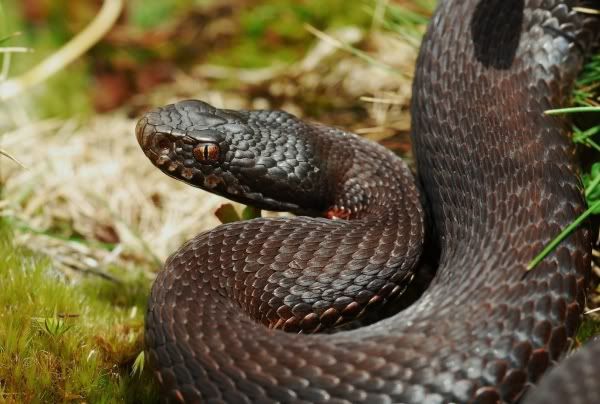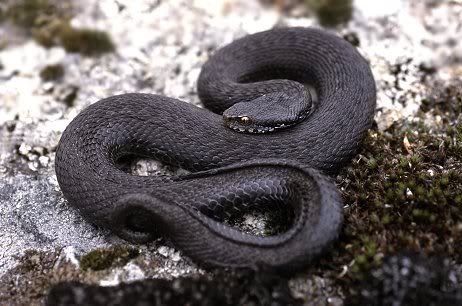So Bellatrix got him a snake
Pretty much the only birthday present he's actually appreciated. And it took me forever to decide on a name and what type of viper she got him exactly, but here it is!
Name: Letalis
Sex: Female
Species: Vipera seoanei seoanei

On the genus Vipera:
Members are usually small and more or less stoutly built. The head is distinct from the neck, of triangular shape, and covered with small scales in many species, although some have a few small plates on top. The dorsal scales are strongly keeled, the anal scale is divided and the subcaudals paired.
They can be found in Great Britain and nearly all of continental Europe, on some small islands of the Mediterranean (Elba, Montecristo, Sicily) and the Aegean Sea, as well as in northern Africa in Morocco, Algeria and Tunisia. It also occurs across the Arctic Circle and eastwards though northern Asia to Sakhalin Island and northern Korea.
Most species prefer cooler environments. Those found at lower latitudes tend to prefer higher altitudes and dryer, rocky habitats, while the species that occur at more northern latitudes prefer lower elevations and environments that have more vegetation and moisture.
Most Vipera species have venom that contains both neurotoxic and hemotoxic components. Bites vary widely in severity. Smaller, northern species, such as V. berus, have only slightly less toxic venom, but inject very little. Others, such as V. ammodytes, are capable of injecting much more with devastating results. However, bites from Vipera species are rarely as severe as those from larger Macrovipera or Daboia.

On V. seoanei:
Description
=Size=
They are born at around 15 cm, growing up to sometimes 65 cm.
=Morphology=
They are short and relatively elegant, sometimes being robust looking (especially females), a noticeable slim short tail for females, males having a longer tail. Their head is less heavily built than that of some other viper species like Asp Viper. They have keeled scales and vertical pupils.
=Patterns & colours=
Highly variable. They are brown, gray or olive in colour, with a darker zigzag pattern on the back and various darker markings on the flanks. The so-called bilineata form has no obvious zigzag but a brownish or reddish wide band running down the back, bordered by more narrow light creamy coloured lines. Their bellies are blackish with lighter spots. Black individuals are not particularly rare. This species is characterised from other vipers by their yellowish tail tip.
Defensive habits
They prefer to escape but if cornered of caught they will hiss very loudly and for long periods, and rapidly sticking with their mouth open. The temperament depends on individual specimens... When they bite, they usually don’t put their fangs to use and they give what is known as a ‘dry bite’ where no venom is injected, we must remember that this snake as like other venomous snakes have not got the capability to envenomate us to harm us but to kill their prey in order to survive.
Venom
The strength of the venom depends on the subspecies, with ssp. cantabrica having the more potent poison. Symptoms in humans are pain, fever, nausea, swelling, etc. but rarely death.

Name: Letalis
Sex: Female
Species: Vipera seoanei seoanei

On the genus Vipera:
Members are usually small and more or less stoutly built. The head is distinct from the neck, of triangular shape, and covered with small scales in many species, although some have a few small plates on top. The dorsal scales are strongly keeled, the anal scale is divided and the subcaudals paired.
They can be found in Great Britain and nearly all of continental Europe, on some small islands of the Mediterranean (Elba, Montecristo, Sicily) and the Aegean Sea, as well as in northern Africa in Morocco, Algeria and Tunisia. It also occurs across the Arctic Circle and eastwards though northern Asia to Sakhalin Island and northern Korea.
Most species prefer cooler environments. Those found at lower latitudes tend to prefer higher altitudes and dryer, rocky habitats, while the species that occur at more northern latitudes prefer lower elevations and environments that have more vegetation and moisture.
Most Vipera species have venom that contains both neurotoxic and hemotoxic components. Bites vary widely in severity. Smaller, northern species, such as V. berus, have only slightly less toxic venom, but inject very little. Others, such as V. ammodytes, are capable of injecting much more with devastating results. However, bites from Vipera species are rarely as severe as those from larger Macrovipera or Daboia.

On V. seoanei:
Description
=Size=
They are born at around 15 cm, growing up to sometimes 65 cm.
=Morphology=
They are short and relatively elegant, sometimes being robust looking (especially females), a noticeable slim short tail for females, males having a longer tail. Their head is less heavily built than that of some other viper species like Asp Viper. They have keeled scales and vertical pupils.
=Patterns & colours=
Highly variable. They are brown, gray or olive in colour, with a darker zigzag pattern on the back and various darker markings on the flanks. The so-called bilineata form has no obvious zigzag but a brownish or reddish wide band running down the back, bordered by more narrow light creamy coloured lines. Their bellies are blackish with lighter spots. Black individuals are not particularly rare. This species is characterised from other vipers by their yellowish tail tip.
Defensive habits
They prefer to escape but if cornered of caught they will hiss very loudly and for long periods, and rapidly sticking with their mouth open. The temperament depends on individual specimens... When they bite, they usually don’t put their fangs to use and they give what is known as a ‘dry bite’ where no venom is injected, we must remember that this snake as like other venomous snakes have not got the capability to envenomate us to harm us but to kill their prey in order to survive.
Venom
The strength of the venom depends on the subspecies, with ssp. cantabrica having the more potent poison. Symptoms in humans are pain, fever, nausea, swelling, etc. but rarely death.
